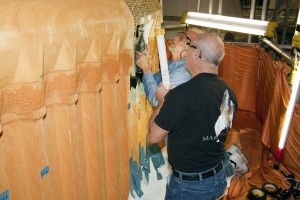Those of you who followed the ATV-1 Jules Verne mission two years ago will recall the tight scheduling surrounding launch, demonstration manoeuvres and actual docking back in March and April of 2008.
[flv:esa_atv_mission_profile.flv 640 384]
ATV mission profile video – credit: ESA 2009 – original via ESA multimedia gallery
At that time, the situation was due to the need to coordinate ATV operations with those of the Shuttle and Russia’s Progress resupply vessel. ATV-1 also had to perform a complex series of ‘demonstration rendezvous manoeuvres‘ to prove its safety and ability to automatically dock to the International Space Station (which went perfectly!).
Now, for ATV-2 Johannes Kepler, a similar situation is developing – but this time dictated by a combination of the Johannes Kepler mission profile, the delays in the launch of Space Shuttle Discovery on the STS-133 transport mission, now delayed to late February due to cracks in the large fuel tank, and the launch and docking of Japan’s HTV-2 (read full details after the jump).
If Discovery had launched in November 2010 as initially planned, it would have been undocked and back on the ground by now. However, now, both ATV-2 and HTV-2 will be docked to the ISS during the STS-133 mission, making for a complex series of comings and goings at the ISS.
Now that the ATV vessel is fully proven, the ATV-2 mission profile is relatively straightforward: it launches on board Ariane 5, attains its injection orbit, spends eight days in free-flight orbit to catch up to the ISS (called ‘phasing’) and then takes up to three days, if needed, for docking attempts. No demonstration rendezvous are required this time, which took almost three weeks of manoeuvring last time for ATV-1.
Thus, if ATV-2 launches on 15 February as now planned, docking will happen as early as 23 February and as late as 26 February. And here’s the first traffic issue: if Shuttle Discovery experiences no further delays and launches on 24 February as currently expected, then it, too, would be docking to the ISS on 26 February.

Repair work to space shuttle Discovery's external fuel tank begins in the Vehicle Assembly Building at NASA's Kennedy Space Center in Florida
“The ISS program does not allow a situation in which both ATV-2 and Discovery have to dock on the same day due to the extraordinary amount of work that would be required of the ISS crew. We definitely have to space out the dockings, and we’re now in active discussions with NASA and the ISS partners to work out a schedule,” said Alberto Novelli, ESA’s Head of the ATV Mission Operations Division, in an email earlier today.
For example, if all proceeds as planned with ATV-2, and it lines up for docking on 23 February, Discovery launch may be held from 24 to 27th February (note that, due to technical and safety reasons, Shuttle can dock to Station when ATV is attached, but the opposite is not permitted). However if some delays occur either with ATV or the Shuttle launch, ATV will have to adopt a phasing strategy that enables docking within the allowable docking windows, which run up to 10 March.
“It’s a challenging situation, and we will have a much better idea on the best possible schedule in the coming days as Discovery repairs are implemented. At the mission operations level, we are elaborating with our CNES colleagues the alternative phasing strategies required to safely dock to ISS in the assigned window. This may imply a slightly longer phasing or a parking phase,” says Novelli.
Finally, the delay in Discovery’s launch is also affecting operations of Japan’s HTV-2, currently planned for launch on 20 January and docking on 27 January. Discovery is scheduled to carry cargo – the ‘Expedite the Processing of Experiments to Space Station’ Logistics Carrier-4 (ExPrESS – ELC-4) – that is necessary as part of HTV-2 activities.
Thanks to Alberto Novelli for information on this situation. We’ll keep you updated!

 Automated Transfer Vehicle page
Automated Transfer Vehicle page ATV blog archive
ATV blog archive
Discussion: no comments